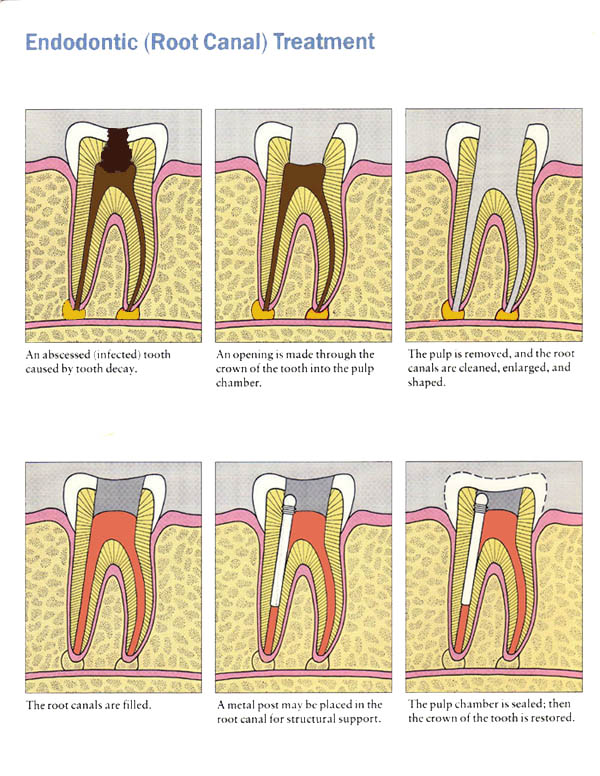What is Root Canal Treament?
Endodontic treatment is also known as root canal treatment. It is a procedure to clean, shape and fill the root canals of a diseased tooth. Our anterior tooth (incisors and cuspid)Â has one canal normally except for lower anterior teeth whereby they may have two. Bicuspids and molars have more than one canal.
Why is Endodontic Treatement necessary?
Anatomy of a tooth

Description of a tooth
Picture taken from http://faculty.washington.edu/chudler/tooth1.gif
A tooth has three layers namely enamel (white matter visible to us), dentine and pulp. When the decay of a tooth has gone down to the pulp region it would cause toothache, sore gums and tooth abscess. If the situation is not dealt with it would cause facial swelling, infection and fever.
A normal filling is adequate if the decay of a tooth only reaches the dentine. If the tooth cavity is deep down to the pulp, bacterial infection may have gone into the root canals. Thus, an endodontic or root canal treatment is necessary to eradicate the infection.
How is an Endodontic Treatment done?
A radiograph (X ray) is required before the commencement of the treatment. A radiograph shows the shape , size, number of canals and how far the tooth abscess has gone to if there is one.
After confirming the diagnosis and if root canal treatment is the desired procedure, the dentist would drill your tooth to remove all decays and debris down to the pulp chamber. After this, the dentist would then explore your pulp chamber to determine the numbers of canals found. Long slender stainless steel or nickel titanium instruments known as endodontic files are used to clean and shape the root canals. Sometimes, multiple visits are required for the cleaning and shaping of root canals depending on the complexity of the case. Fine canals require more time and expertise. When cleaning and shaping of root canals are done, another radiograph would be taken to confirm the correct length of the root canal for the treatment. After that, a canal medicament is placed inside the root canals for antiseptic purposes and rid of pain. A temporary dressing is placed at the access cavity of the treatment to bar off food debris and prevent re-infection by bacteria. Dentist would also prescribe oral medications to aid in the healing process.
Usually an endodontic treatment requires at least two visits. First visit is for cleaning and shaping of the root canal and the subsequent visit is for filling of the root canals.
What comes after this?
A successful root canal treatment would be free of pain, no mobility of the tooth, healing of dental abscess and surrounding tissues of the tooth.
When an endodontic treatment is undergone, the tooth is deprived of its blood and nerve supply. Thus, the tooth changes color, becomes brittle and fragile. A root treated tooth requires a dental crown to protect it from cracks and fractures. Some badly broken tooth would require dental post to act as a support to the core of the dental crown. As for color changes, tooth whitening could be of help. Usually an internal whitening method is suggested if the dental crown treatment is postponed. If the patient plans to do a dental crown after the endodontic treatment, tooth whitening is not necessary.

Pros and Cons
Endodontic treatment helps preserve your original tooth. In the event of a deeply decayed painful tooth, it prevents tooth extraction if it is successful. Preserving tooth means preserving the bony support as well so we lose nothing.
On the contrary, if the endodontic treatment fails, tooth extraction is inevitable. Dental implants and dental bridges would be the treatment options later on.
Personally, I still feel we should try all possible means to save our teeth before thinking of extracting it.
Pingback: Teeth Whitening: Laser Teeth Whitening | Intelligent Dental
Pingback: How to Decide Between a Dental Bridge and a Post | Intelligent Dental